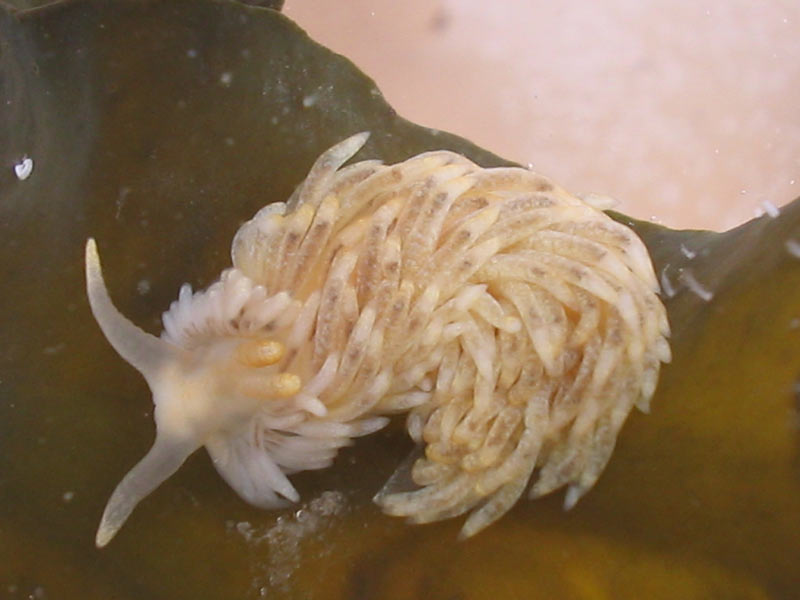A sea slug (Aeolidiella alderi)
Distribution data supplied by the Ocean Biodiversity Information System (OBIS). To interrogate UK data visit the NBN Atlas.Map Help
| Researched by | Sonia Rowley | Refereed by | Admin |
| Authority | (Cocks, 1852) | ||
| Other common names | - | Synonyms | Eolida soemmerringii |
Summary
Description
Recorded distribution in Britain and Ireland
Recorded from St. Abbs Harbour, east Scotland; Poole harbour and Plymouth Sound, England; Lough Hyne, Mulroy Bay and the Garvan Isles, Ireland, and Loch Sunart, west Scotland.Global distribution
-Habitat
This is an intertidal species which feeds on sea anemones.Depth range
-Identifying features
- Two oral tentacles, longer than rhinophores.
- Numerous cerata.
- Tips of the cerata are white or pale in colour, particularly at the anterior end of the body, forming a white ruff around the body. The body is pale cream/fawn in colour.
- Up to 37 mm in length.
Additional information
Spawn forms a convoluted spiral thread containing 200-1200 large eggs. Development is direct, i.e. there is no larval stage. Aeolidiella alderi feeds on a variety of sea anemonies mainly Cereus pedunculatus, Diadumene cincta and Sagartia species (Picton & Morrow, 1994). The body of Aeolidiella alderi is more slender than Aeolidia papillosa (Thompson & Brown, 1984).Listed by
- none -
Bibliography
Crothers, J.H. (ed.), 1966. Dale Fort Marine Fauna. London: Field Studies Council.
Howson, C.M. & Picton, B.E., 1997. The species directory of the marine fauna and flora of the British Isles and surrounding seas. Belfast: Ulster Museum. [Ulster Museum publication, no. 276.]
JNCC (Joint Nature Conservation Committee), 1999. Marine Environment Resource Mapping And Information Database (MERMAID): Marine Nature Conservation Review Survey Database. [on-line] http://www.jncc.gov.uk/mermaid
MBA (Marine Biological Association), 1957. Plymouth Marine Fauna. Plymouth: Marine Biological Association of the United Kingdom.
Picton, B. E. & Morrow, C.C., 1994. A Field Guide to the Nudibranchs of the British Isles. London: Immel Publishing Ltd.
Picton, B.E. & Costello, M.J., 1998. BioMar biotope viewer: a guide to marine habitats, fauna and flora of Britain and Ireland. [CD-ROM] Environmental Sciences Unit, Trinity College, Dublin.
Sanderson, W.G., 1996. Rare benthic marine flora and fauna in Great Britain: the development of criteria for assessment. Joint Nature Conservation Committee, Peterborough. JNCC Report, no. 240.
Seaward, D.R., 1982. Sea area atlas of the marine molluscs of Britain and Ireland. Peterborough: Nature Conservancy Council.
Thompson, T. E. & Brown, G. H., 1976. British Opisthobranch Molluscs. London: Academic Press. [Synopses of the British Fauna, no. 8.]
Thompson, T.E. & Brown, G.H., 1984. Biology of Opisthobranch Molluscs, vol. II. London: Ray Society.
Thompson, T.E., 1976. Biology of Opisthobranch Molluscs, vol. 1. London: The Ray Society.
Datasets
Conchological Society of Great Britain & Ireland, 2018. Mollusc (marine) data for Great Britain and Ireland - restricted access. Occurrence dataset: https://doi.org/10.15468/4bsawx accessed via GBIF.org on 2018-09-25.
Conchological Society of Great Britain & Ireland, 2023. Mollusc (marine) records for Great Britain and Ireland. Occurrence dataset: https://doi.org/10.15468/aurwcz accessed via GBIF.org on 2024-09-27.
Fenwick, 2018. Aphotomarine. Occurrence dataset http://www.aphotomarine.com/index.html Accessed via NBNAtlas.org on 2018-10-01
NBN (National Biodiversity Network) Atlas. Available from: https://www.nbnatlas.org.
OBIS (Ocean Biodiversity Information System), 2025. Global map of species distribution using gridded data. Available from: Ocean Biogeographic Information System. www.iobis.org. Accessed: 2025-07-15
Citation
This review can be cited as:
Last Updated: 13/08/2007



